Fault State Identification Method with Noise Robustness of Dry Gas Seals Based on Sample-Augmented MA1D-ResNet
Abstract
1. Introduction
- Experimental Design and Data Enhancement: We designed seven common operational conditions, including four structural fault conditions of the seal face and three operational states during startup: dry friction (50 rpm), mixed lubrication (600 rpm), and stable operation (1000 rpm). AE technology was used to monitor the seal status. A data augmentation strategy involving noise injection was implemented to expand the sample set and enhance the noise robustness of the input data.
- Novel Diagnostic Model: We propose the MA1D-ResNet model for dry gas seal fault diagnosis. The model incorporates a multi-scale spatial attention mechanism, integrating three different convolutional kernels for signal feature identification, combined with a channel attention module and ResNet architecture. This design enables accurate extraction of multi-scale fault-related features from AE signals.
- Comprehensive Validation: We validated the data augmentation method and the MA1D-ResNet model using a self-constructed dataset. Comparative experiments with five existing models under identical parameter settings, including accuracy, loss, and noise immunity tests, demonstrate that our method offers superior diagnostic performance and better robustness to noise.
2. Proposed Method for Fault Diagnosis of Dry Gas Seal
2.1. One-Dimensional Residual Neural Network
2.2. Attention Module
2.2.1. Channel Attention Module
2.2.2. Multi-Scale Spatial Attention Module
2.2.3. Multi-Scale Dual Attention Module (MDAM)
2.3. Fault Identification Method Based on MA1D-ResNet
2.4. Construction of the Test Platform and Database
2.4.1. Introduction to the Test Platform
2.4.2. Construction of Fault Database
2.5. Fault Diagnosis Process of Sealing End Face Based on MA1D-ResNet
- (1)
- Signal Acquisition and Dataset Partition
- (2)
- Model Training
- (3)
- Fault Identification and Classification
3. Results
3.1. Visualization of Weights
3.2. Performance Evaluation
3.3. Analysis of Model Noise Resistance
3.4. Impact of Data Augmentation Techniques on Model Noise Robustness
3.5. t-SNE Visualization Analysis
4. Conclusions and Prospects
- (1)
- The proposed model demonstrates excellent performance in dry gas seal fault classification, achieving an accuracy of 99.8571% on the test set. Under identical parameter settings, it significantly outperforms other 1D-CNN-based models, including CNN, ResNet, MA1D-CNN, ResNet-SE, and ResNet-CBAM, exhibiting both higher accuracy and superior convergence.
- (2)
- Comparative experiments with six different deep learning models under noisy conditions confirm that the proposed model maintains high recognition accuracy and strong noise resistance, even under substantial noise interference.
- (3)
- The use of data augmentation techniques—specifically data segmentation and Gaussian noise injection—substantially enhances the model’s generalization ability and noise robustness. Comparative experiments confirm that the augmented model outperforms the non-augmented version in terms of accuracy, training loss, and anti-noise performance.
Author Contributions
Funding
Institutional Review Board Statement
Informed Consent Statement
Data Availability Statement
Conflicts of Interest
References
- Wang, Y.; Yang, H.; Wang, J.; Liu, Y.; Wang, H.; Feng, X. Theoretical Analyses and Field Applications of Gas-Film Lubricated Mechanical Face Seals with Herringbone Spiral Grooves. Tribol. Trans. 2009, 52, 800–806. [Google Scholar] [CrossRef]
- García Márquez, F.P.; Tobias, A.M.; Pinar Pérez, J.M.; Papaelias, M. Condition Monitoring of Wind Turbines: Techniques and Methods. Renew. Energy 2012, 46, 169–178. [Google Scholar] [CrossRef]
- Purarjomandlangrudi, A.; Nourbakhsh, G. Acoustic emission condition monitoring: An application for wind turbine fault detection. Int. J. Res. Eng. Technol. 2013, 2, 907–918. [Google Scholar] [CrossRef]
- Toutountzakis, T.; Tan, C.K.; Mba, D. Application of Acoustic Emission to Seeded Gear Fault Detection. NDT E Int. 2005, 38, 27–36. [Google Scholar] [CrossRef]
- Loutas, T.H.; Sotiriades, G.; Kalaitzoglou, I.; Kostopoulos, V. Condition Monitoring of a Single-Stage Gearbox with Artificially Induced Gear Cracks Utilizing on-Line Vibration and Acoustic Emission Measurements. Appl. Acoust. 2009, 70, 1148–1159. [Google Scholar] [CrossRef]
- Umar, M.; Siddique, M.F.; Ullah, N.; Kim, J.-M. Milling Machine Fault Diagnosis Using Acoustic Emission and Hybrid Deep Learning with Feature Optimization. Appl. Sci. 2024, 14, 10404. [Google Scholar] [CrossRef]
- Rogers, L.M. The Application of Vibration Signature Analysis and Acoustic Emission Source Location to On-Line Condition Monitoring of Anti-Friction Bearings. Tribol. Int. 1979, 12, 51–58. [Google Scholar] [CrossRef]
- Al-Ghamd, A.M.; Mba, D.A. Comparative Experimental Study on the Use of Acoustic Emission and Vibration Analysis for Bearing Defect Identification and Estimation of Defect Size. Mech. Syst. Signal Process. 2006, 20, 1537–1571. [Google Scholar] [CrossRef]
- Williams, M.; Barnes, N.D. The use of acoustic emissions for monitoring mechanical seals. In Proceedings of the 13th BPMA Pump Technical Conference, Nottingham, UK, June 1993. [Google Scholar]
- Towsyfyan, H.; Gu, F.; Ball, A.D.; Liang, B. Modelling Acoustic Emissions Generated by Tribological Behaviour of Mechanical Seals for Condition Monitoring and Fault Detection. Tribol. Int. 2018, 125, 46–58. [Google Scholar] [CrossRef]
- Medina-Arenas, M.; Sopp, F.; Stolle, J.; Schley, M.; Kamieth, R.; Wassermann, F. Measurement and Analysis of Inadequate Friction Mechanisms in Liquid-Buffered Mechanical Seals Utilizing Acoustic Emission Technique. Vibration 2021, 4, 263–283. [Google Scholar] [CrossRef]
- Huang, W.; Lin, Y.; Liu, Y.; Liu, X.; Gao, Z.; Wang, Y. Face Rub-Impact Monitoring of a Dry Gas Seal Using Acoustic Emission. Tribol. Lett. 2013, 52, 253–259. [Google Scholar] [CrossRef]
- Fan, W.; Huang, W.; Liu, Y.; Yin, Y.; Liu, X.; Wang, Y. State Evolution of Dry Gas Seal during Repeated Start–Stop Operation Using Acoustic Emission Method. Tribol. Trans. 2020, 63, 173–181. [Google Scholar] [CrossRef]
- Yin, Y.; Huang, W.; Liu, X.; Liu, Y.; Wang, Z.; Fan, W.; Hu, S. Analysis of the Dynamic Friction of a Gas Face Seal Based on Acoustic Emissions. Tribol. Lett. 2018, 66, 85. [Google Scholar] [CrossRef]
- Yin, Y.; Liu, X.; Huang, W.; Liu, Y.; Hu, S. Gas Face Seal Status Estimation Based on Acoustic Emission Monitoring and Support Vector Machine Regression. Adv. Mech. Eng. 2020, 12, 1687814020921323. [Google Scholar] [CrossRef]
- Ding, J.; Yu, S.; Lu, J.; Ding, X. Control and Analysis of Floating Ability of Aeronautical Cylindrical Spiral Groove Gas Seal Based on F-K Model. Sage J. 2024, 16, 16878132241236591. [Google Scholar] [CrossRef]
- Ding, J.; Yu, S.; Liu, Z.; Wang, S.; Lu, J. Fault Diagnosis of Dry Gas Seal Operation Status Based on Acoustic Emission Monitoring. Lubricants 2024, 12, 35. [Google Scholar] [CrossRef]
- Hashtrudi Zad, S.; Kwong, R.H.; Wonham, W.M. Fault Diagnosis in Discrete-Event Systems: Incorporating Timing Information. IEEE Trans. Autom. Control 2005, 50, 1010–1015. [Google Scholar] [CrossRef]
- Chen, Z.; Cen, J.; Xiong, J. Rolling Bearing Fault Diagnosis Using Time-Frequency Analysis and Deep Transfer Convolutional Neural Network. IEEE Access 2020, 8, 150248–150261. [Google Scholar] [CrossRef]
- Pacheco, F.; Drimus, A.; Duggen, L.; Cerrada, M.; Cabrera, D.; Sanchez, R.-V. Deep Ensemble-Based Classifier for Transfer Learning in Rotating Machinery Fault Diagnosis. IEEE Access 2022, 10, 29778–29787. [Google Scholar] [CrossRef]
- Chen, Z.; Li, C.; Sanchez, R.-V. Gearbox Fault Identification and Classification with Convolutional Neural Networks. Shock Vib. 2015, 2015, 390134. [Google Scholar] [CrossRef]
- He, J.; Li, X.; Chen, Y.; Chen, D.; Guo, J.; Zhou, Y. Deep Transfer Learning Method Based on 1D-CNN for Bearing Fault Diagnosis. Shock Vib. 2021, 2021, 6687331. [Google Scholar] [CrossRef]
- Jiang, G.; He, H.; Yan, J.; Xie, P. Multiscale Convolutional Neural Networks for Fault Diagnosis of Wind Turbine Gearbox. IEEE Trans. Ind. Electron. 2019, 66, 3196–3207. [Google Scholar] [CrossRef]
- Jing, L.; Zhao, M.; Li, P.; Xu, X. A Convolutional Neural Network Based Feature Learning and Fault Diagnosis Method for the Condition Monitoring of Gearbox. Measurement 2017, 111, 1–10. [Google Scholar] [CrossRef]
- Pang, P.; Tang, J.; Rui, T.; Gong, J.; He, Y. Research on Fault Diagnosis and Feature Extraction Mechanism Visualization of Rotating Machinery Based on Improved 1D CNN. Adv. Mech. Eng. 2024, 16, 16878132241289258. [Google Scholar] [CrossRef]
- Peng, D.; Liu, Z.; Wang, H.; Qin, Y.; Jia, L. A Novel Deeper One-Dimensional CNN With Residual Learning for Fault Diagnosis of Wheelset Bearings in High-Speed Trains. IEEE Access 2019, 7, 10278–10293. [Google Scholar] [CrossRef]
- Zhang, T.; Xu, F.; Jia, M. A Centrifugal Fan Blade Damage Identification Method Based on the Multi-Level Fusion of Vibro-Acoustic Signals and CNN. Measurement 2022, 199, 111475. [Google Scholar] [CrossRef]
- Xu, H.; Wang, X.; Huang, J.; Zhang, F.; Chu, F. Semi-Supervised Multi-Sensor Information Fusion Tailored Graph Embedded Low-Rank Tensor Learning Machine under Extremely Low Labeled Rate. Inf. Fusion 2024, 105, 102222. [Google Scholar] [CrossRef]
- Prasshanth, C.V.; Naveen Venkatesh, S.; Mahanta, T.K.; Sakthivel, N.R.; Sugumaran, V. Fault Diagnosis of Monoblock Centrifugal Pumps Using Pre-Trained Deep Learning Models and Scalogram Images. Eng. Appl. Artif. Intell. 2024, 136, 109022. [Google Scholar] [CrossRef]
- Zhou, J.; Huang, W.; Dai, H.; Wang, C.; Zhong, Y. Data-Driven Battery Remaining Life Prediction Based on ResNet with GA Optimization. World Electr. Veh. J. 2025, 16, 267. [Google Scholar] [CrossRef]
- Xianguo, L.; Ying, C.; Yi, L. A Novel Convolutional Neural Network with Global Perception for Bearing Fault Diagnosis. Eng. Appl. Artif. Intell. 2025, 143, 109986. [Google Scholar] [CrossRef]
- Jichao, Y.; Ying, S.; Chen, W.; Yuankai, D.; Jian, Y.; Maocheng, S.; Sheng, H.; Shuai, Q.; Wenan, Z.; Yanjie, Z.; et al. An Intelligent Crash Recognition Method Based on 1DResNet-SVM with Distributed Vibration Sensors. Opt. Commun. 2023, 536, 129263. [Google Scholar] [CrossRef]
- Zhang, W.; Yang, D.; Wang, H.; Huang, X.; Gidlund, M. CarNet: A Dual Correlation Method for Health Perception of Rotating Machinery. IEEE Sens. J. 2019, 19, 7095–7106. [Google Scholar] [CrossRef]
- Wang, H.; Xu, J.; Yan, R.; Gao, R.X. A New Intelligent Bearing Fault Diagnosis Method Using SDP Representation and SE-CNN. IEEE Trans. Instrum. Meas. 2020, 69, 2377–2389. [Google Scholar] [CrossRef]
- Zhang, X.; Zhang, X.; Liang, W.; He, F. Research on Rolling Bearing Fault Diagnosis Based on Parallel Depthwise Separable ResNet Neural Network with Attention Mechanism. Expert Syst. Appl. 2025, 286, 128105. [Google Scholar] [CrossRef]
- Han, S.; Sun, S.; Zhao, Z.; Luan, Z.; Niu, P. Deep Residual Multiscale Convolutional Neural Network With Attention Mechanism for Bearing Fault Diagnosis Under Strong Noise Environment. IEEE Sens. J. 2024, 24, 9073–9081. [Google Scholar] [CrossRef]
- Chen, Z.; Liu, J.; Du, Z.; Fan, X.; Luo, H. A Noise-Resilient Fault Diagnosis Method Based on Optimized Residual Networks. IEEE Trans. Instrum. Meas. 2025, 74, 3532410. [Google Scholar] [CrossRef]
- He, K.; Zhang, X.; Ren, S.; Sun, J. Deep Residual Learning for Image Recognition. In Proceedings of the 2015 IEEE Conference on Computer Vision and Pattern Recognition (CVPR), Boston, MA, USA, 7–12 June 2015. [Google Scholar]
- Hamrock, B.J.; Schmid, S.R.; Jacobson, B.O. Fundamentals of Fluid Film Lubrication; CRC Press: Boca Raton, FL, USA, 2004; ISBN 0-429-21531-2. [Google Scholar] [CrossRef]
- Lubbinge, H. On the Lubrication of Mechanical Face Seals. Ph.D. Thesis, University of Twente, Enschede, The Netherlands, 1999. [Google Scholar] [CrossRef]
- Chen, J.; Lu, J.; Hou, Y.; Ding, X.; Zhang, W. Study on the Friction Behavior and Abnormal Conditions of Non-Contact Mechanical Seal Based on Acoustic Emission. Tribol. Lett. 2024, 72, 71. [Google Scholar] [CrossRef]
- Huang, G.; Wu, S.; Zhang, Y.; Wei, W.; Fu, W.; Zhang, J.; Yang, Y.; Fu, J. AttenResNet18: A Novel Cross-Domain Fault Diagnosis Model for Rolling Bearings. Sensors 2025, 25, 5958. [Google Scholar] [CrossRef]
- He, K.; Zhang, X.; Ren, S.; Sun, J. Delving Deep into Rectifiers: Surpassing Human-Level Performance on ImageNet Classification. In Proceedings of the 2015 IEEE Conference on Computer Vision and Pattern Recognition (CVPR), Boston, MA, USA, 7–12 June 2015. [Google Scholar]
- Chen, C.-C.; Liu, Z.; Yang, G.; Wu, C.-C.; Ye, Q. An Improved Fault Diagnosis Using 1D-Convolutional Neural Network Model. Electronics 2021, 10, 59. [Google Scholar] [CrossRef]
- Tchatchoua, P.; Graton, G.; Ouladsine, M.; Christaud, J.-F. Application of 1D ResNet for Multivariate Fault Detection on Semiconductor Manufacturing Equipment. Sensors 2023, 23, 9099. [Google Scholar] [CrossRef]
- Gu, X.; Tian, Y.; Li, C.; Wei, Y.; Li, D. Improved SE-ResNet Acoustic–Vibration Fusion for Rolling Bearing Composite Fault Diagnosis. Appl. Sci. 2024, 14, 2182. [Google Scholar] [CrossRef]
- Liang, B.; Feng, W. Bearing Fault Diagnosis Based on ICEEMDAN Deep Learning Network. Processes 2023, 11, 2440. [Google Scholar] [CrossRef]
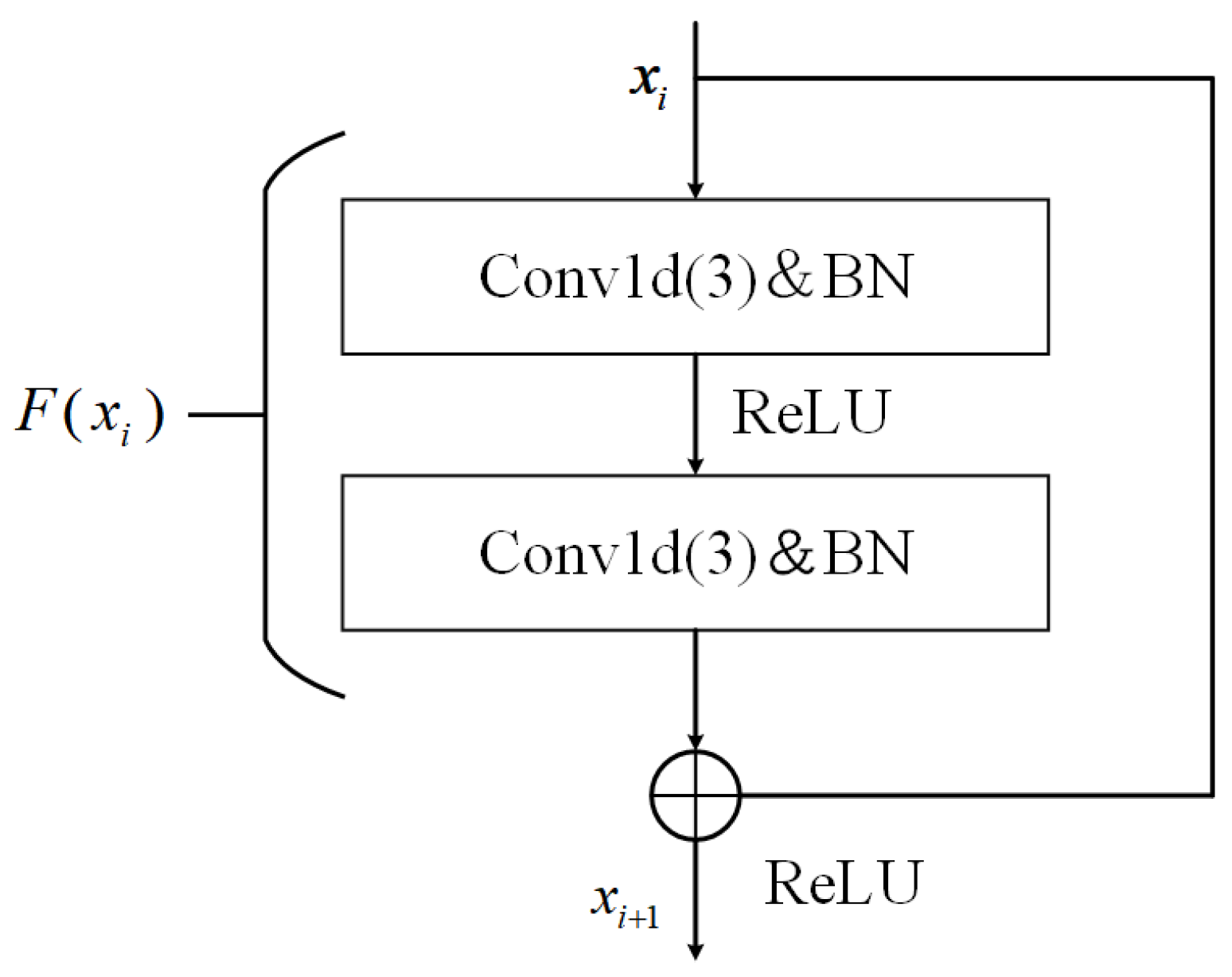


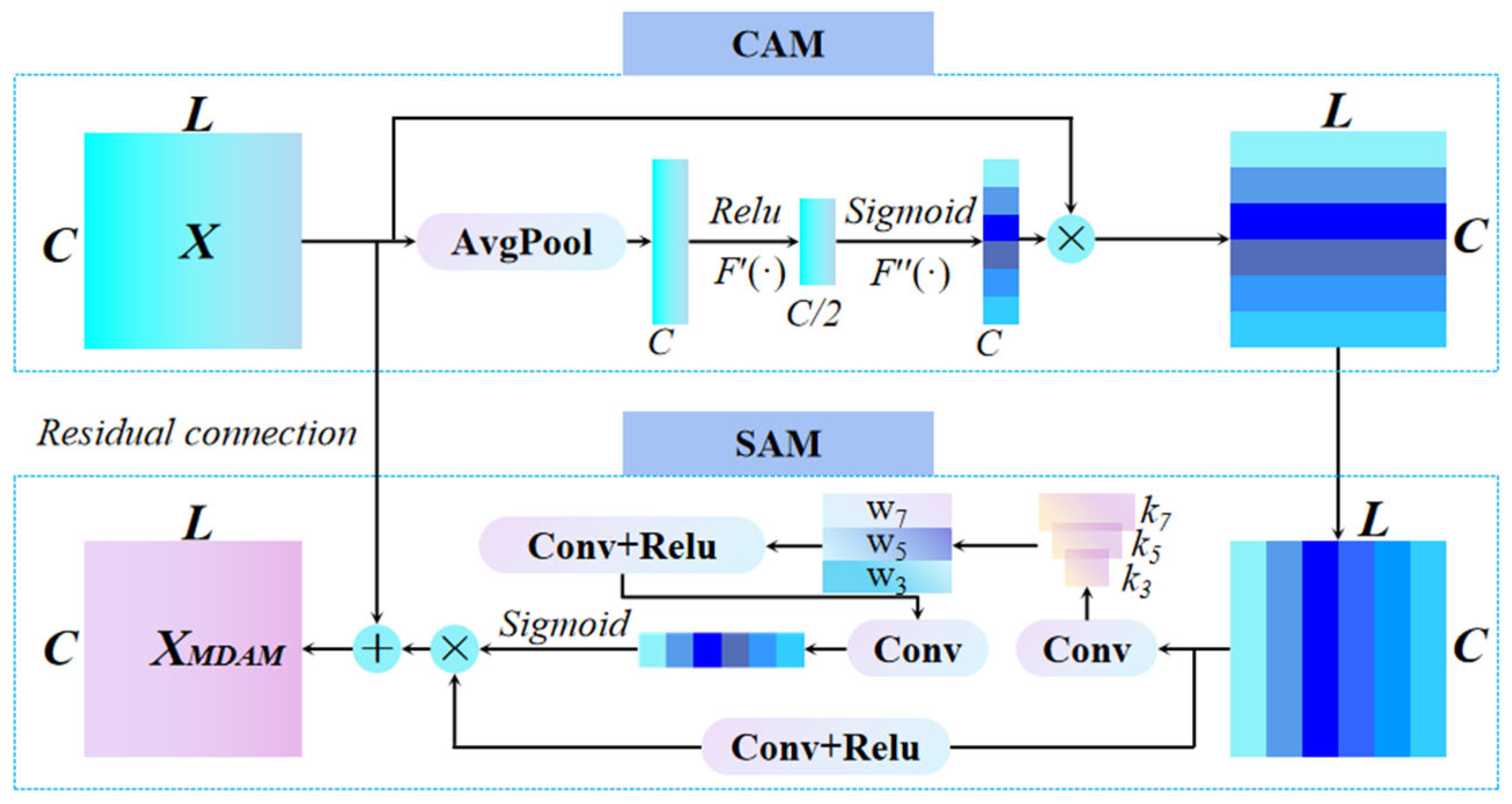
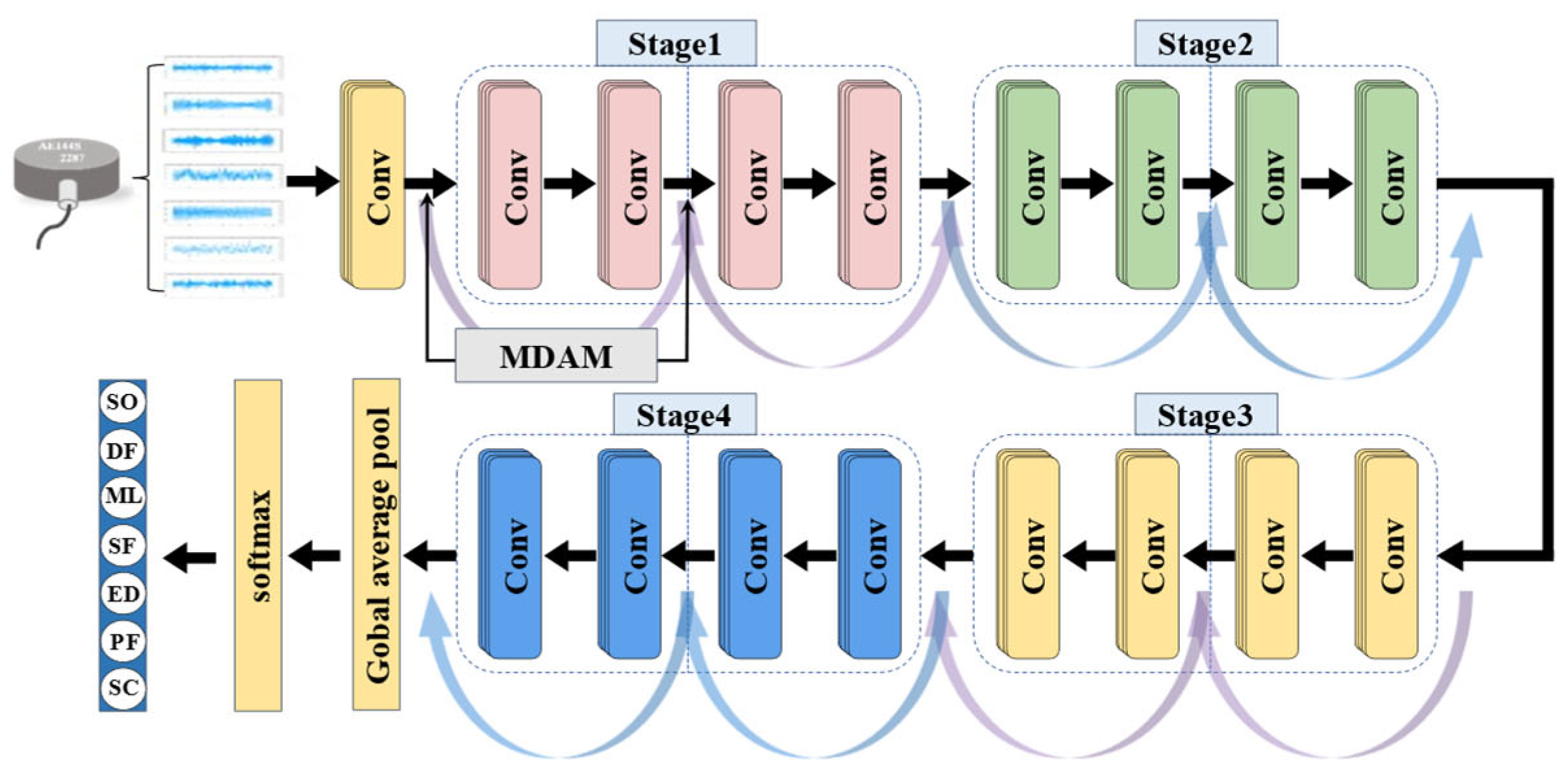



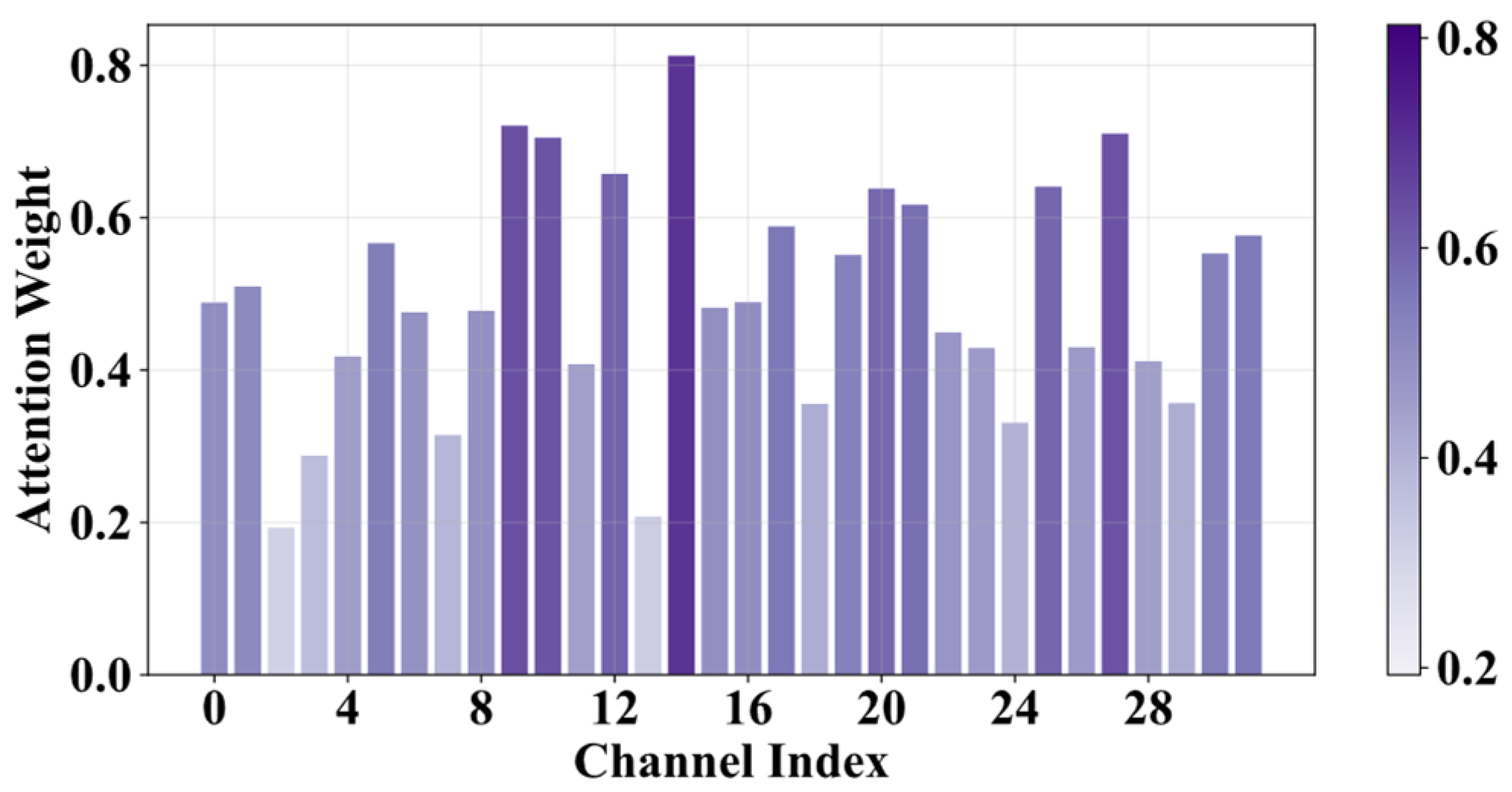
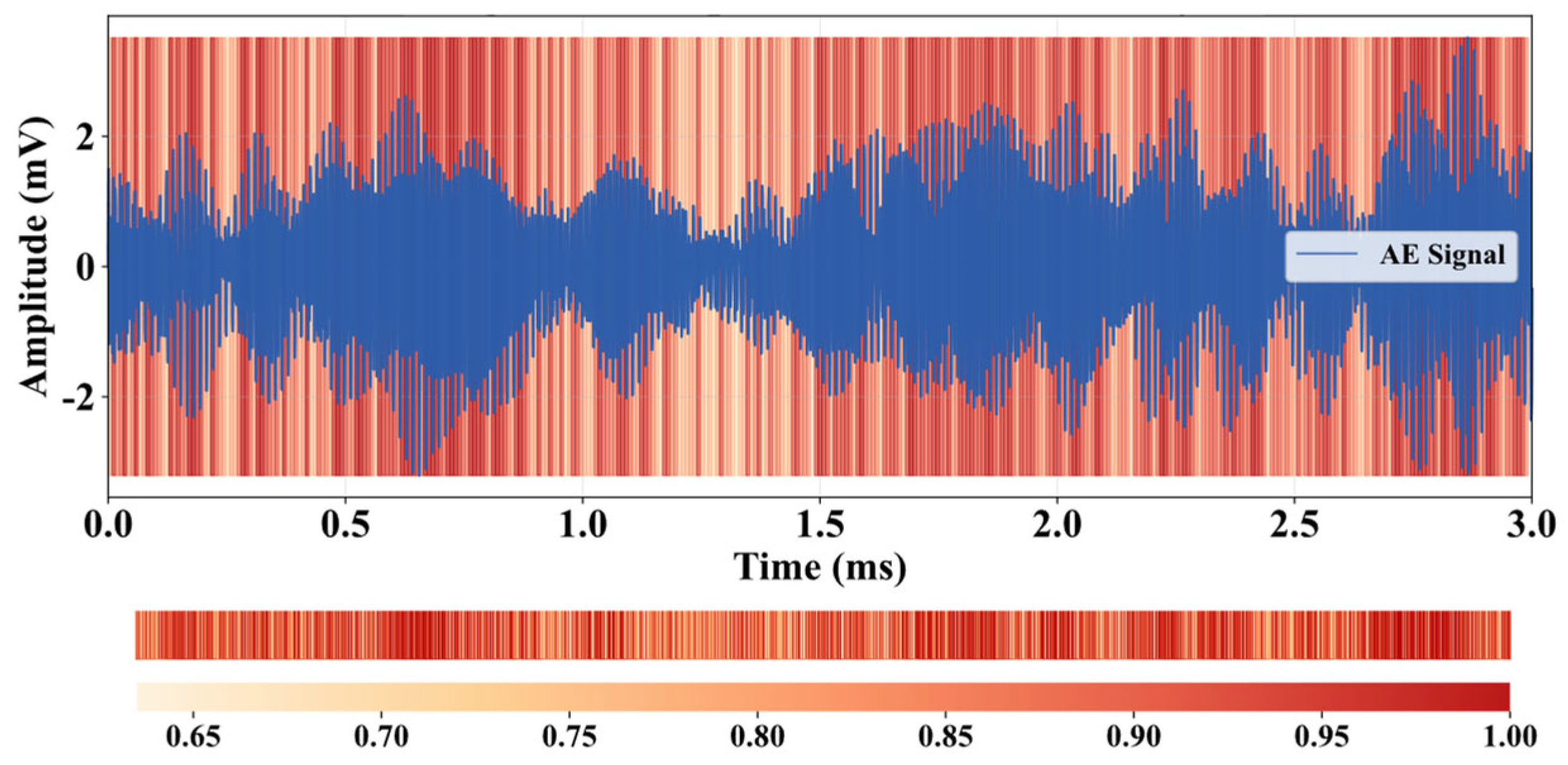
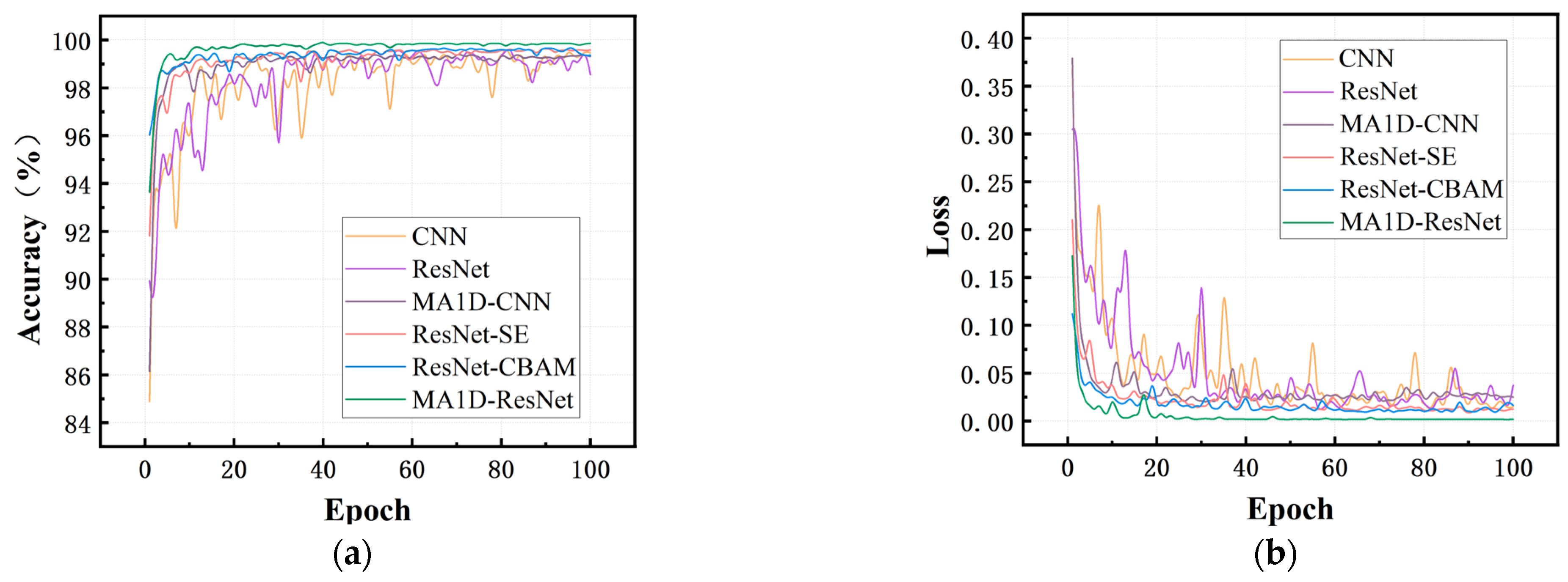

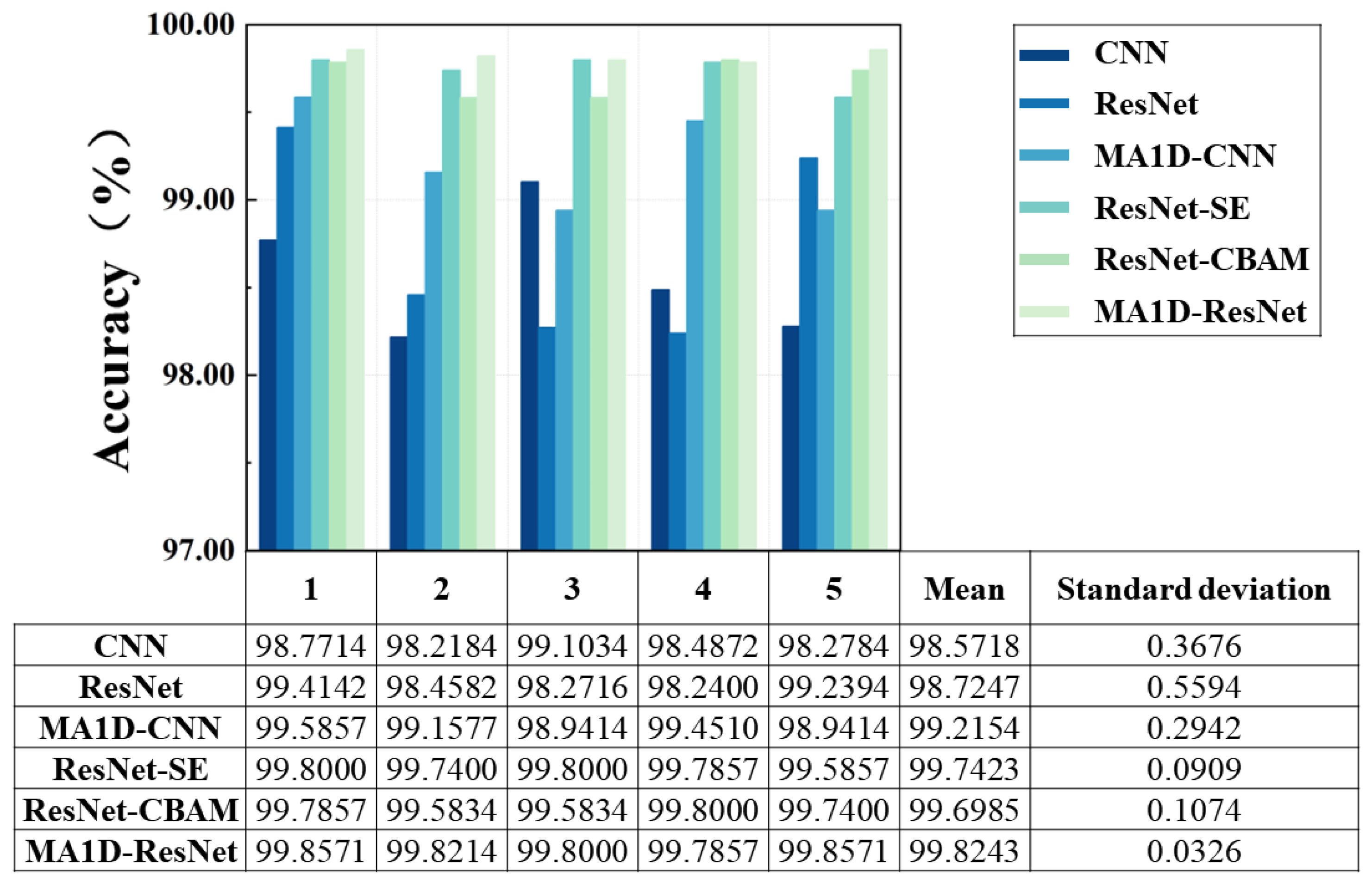
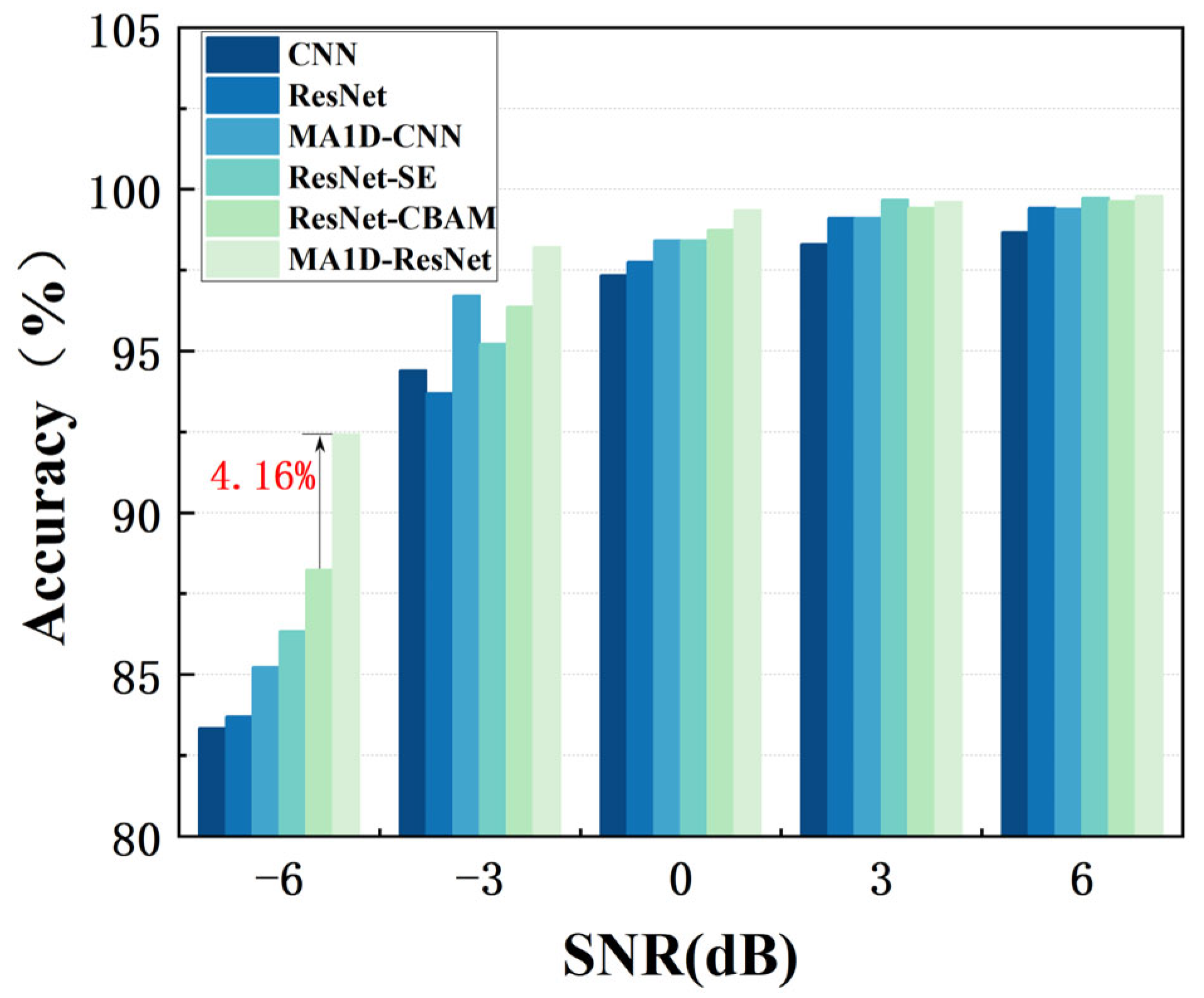
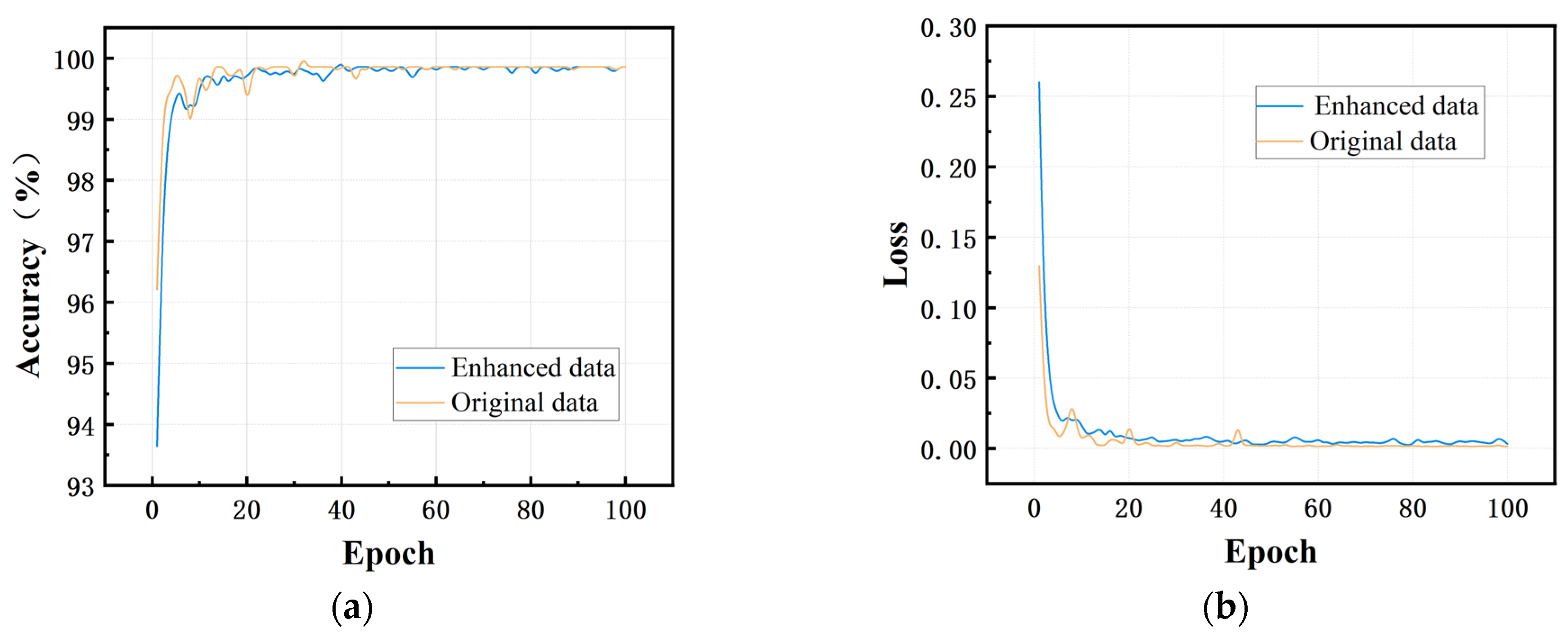
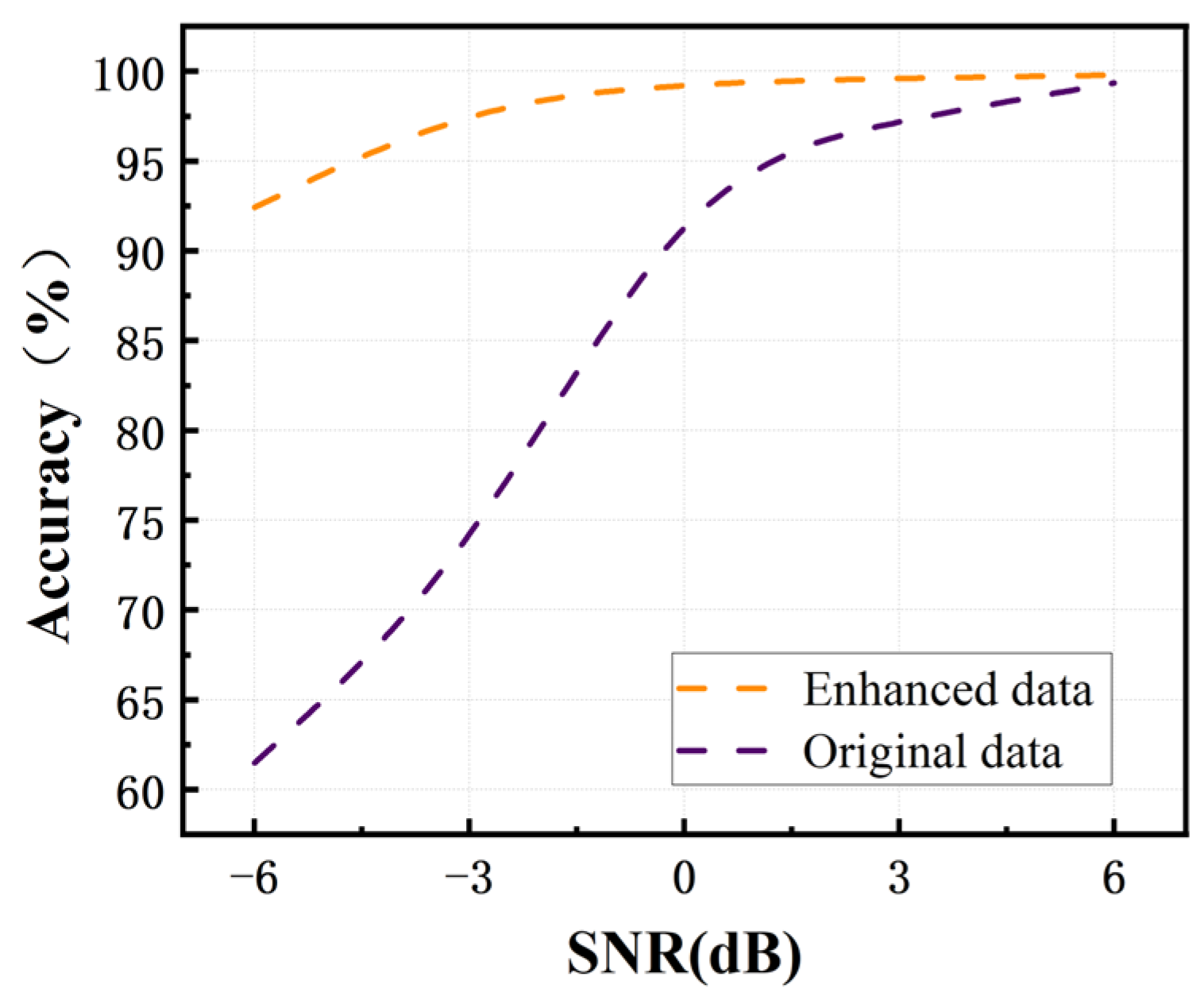


| Layer | Type | Kernel | Channel | Stride | Attention | Output |
|---|---|---|---|---|---|---|
| 0 | Input | 3750 × 1 | ||||
| 1 | Conv | 7 × 1 | 16 | 2 | MDAM | 3750 × 16 |
| 2 | Stage1 | 3 × 1 | 32 | 2 | MDAM | 1875 × 32 |
| 3 | Stage2 | 3 × 1 | 64 | 2 | 938 × 64 | |
| 4 | Stage3 | 3 × 1 | 128 | 2 | 469 × 128 | |
| 5 | Stage4 | 3 × 1 | 256 | 2 | 235 × 256 | |
| Global average pooling and softmax | ||||||
| SO DF ML SF ED PF SC | ||||||
| Operating Condition | Category | Abbreviation | Training Sample | Speed (rpm) | SNR (dB) | Lable Index |
|---|---|---|---|---|---|---|
| Normal | Stable operation | SO | 7000 | 1000 | −2, 0, 2, 4 | 0 |
| Structural failure | Spring failure (uniform distribution) | SF | 7000 | 1000 | −2, 0, 2, 4 | 1 |
| Partial spring failure | PF | 7000 | 1000 | −2, 0, 2, 4 | 2 | |
| Rotary ring end face dent | ED | 7000 | 1000 | −2, 0, 2, 4 | 3 | |
| Scratch on end face of static ring | SC | 7000 | 1000 | −2, 0, 2, 4 | 4 | |
| Start-stop failure | Dry friction | DF | 7000 | 50 | −2, 0, 2, 4 | 5 |
| Mixed lubrication | ML | 7000 | 600 | −2, 0, 2, 4 | 6 |
| Hyperparameter | Search Range | Optimal Value | Remarks |
|---|---|---|---|
| Learning Rate | [1 × 10−4, 5 × 10−4, 1 × 10−3, 5 × 10−3] | 1 × 10−3 | Adam optimizer |
| Batch Size | [32, 64, 128] | 64 | Balance of convergence a |
| Channel Reduction Ratio | [2, 4, 8] | 2 | Channel attention compression |
| Dropout Rate | [0.2, 0.3, 0.5] | 0.5 | Final classification layer |
| Attention Dropout | [0.1, 0.2, 0.3] | 0.2 | Attention fusion module |
| Kernel Sizes | [3, 5, 7], [5, 7, 9], [7, 9, 11] | [3, 5, 7] | Multi-scale spatial attention |
| Indicators | Seed (42) | Seed (43) | Seed (44) | Seed (45) | Seed (46) | Mean | Standard Deviation |
|---|---|---|---|---|---|---|---|
| Accuracy | 99.7500% | 99.7857% | 99.8214% | 99.7857% | 99.8571% | 99.8000% | 0.0364% |
| Precision | 99.7522% | 99.7876% | 99.8229% | 99.7873% | 99.8586% | 99.8017% | 0.0362% |
| Recall | 99.7500% | 99.7857% | 99.8214% | 99.7857% | 99.8571% | 99.8000% | 0.0364% |
| SNR (dB) | CNN (Acc%) | ResNet (Acc%) | MA1D-CNN (Acc%) | ResNet-SE (Acc%) | ResNet-CBAM (Acc%) | MA1D-ResNet (Acc%) |
|---|---|---|---|---|---|---|
| −6 | 83.35 | 83.70 | 85.23 | 86.35 | 88.25 | 92.41 |
| −3 | 94.41 | 93.70 | 96.71 | 95.23 | 96.37 | 98.21 |
| 0 | 97.353 | 97.75 | 98.42 | 98.42 | 98.75 | 99.36 |
| 3 | 98.31 | 99.12 | 99.12 | 99.68 | 99.42 | 99.61 |
| 6 | 98.68 | 99.42 | 99.39 | 99.74 | 99.64 | 99.79 |
Disclaimer/Publisher’s Note: The statements, opinions and data contained in all publications are solely those of the individual author(s) and contributor(s) and not of MDPI and/or the editor(s). MDPI and/or the editor(s) disclaim responsibility for any injury to people or property resulting from any ideas, methods, instructions or products referred to in the content. |
© 2025 by the authors. Licensee MDPI, Basel, Switzerland. This article is an open access article distributed under the terms and conditions of the Creative Commons Attribution (CC BY) license (https://creativecommons.org/licenses/by/4.0/).
Share and Cite
Chen, J.; Li, J.; Ding, X.; Xu, W.; Li, P.; Xia, Z. Fault State Identification Method with Noise Robustness of Dry Gas Seals Based on Sample-Augmented MA1D-ResNet. Sensors 2025, 25, 7005. https://doi.org/10.3390/s25227005
Chen J, Li J, Ding X, Xu W, Li P, Xia Z. Fault State Identification Method with Noise Robustness of Dry Gas Seals Based on Sample-Augmented MA1D-ResNet. Sensors. 2025; 25(22):7005. https://doi.org/10.3390/s25227005
Chicago/Turabian StyleChen, Jinlin, Jiahao Li, Xuexing Ding, Wei Xu, Pengju Li, and Zhihao Xia. 2025. "Fault State Identification Method with Noise Robustness of Dry Gas Seals Based on Sample-Augmented MA1D-ResNet" Sensors 25, no. 22: 7005. https://doi.org/10.3390/s25227005
APA StyleChen, J., Li, J., Ding, X., Xu, W., Li, P., & Xia, Z. (2025). Fault State Identification Method with Noise Robustness of Dry Gas Seals Based on Sample-Augmented MA1D-ResNet. Sensors, 25(22), 7005. https://doi.org/10.3390/s25227005





